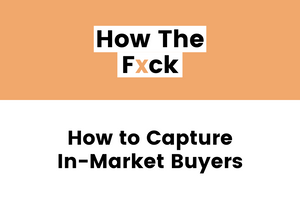3% of your ideal customers are in-market buyers right now. They're ready to purchase and looking for products. Here's how to capture them.
--
A friends startups just pivoted.
They were Apple, now they’re eBay.
In other words, they used to sell their own product, but now they need to find others to sell theirs on their marketplace.
They came to me with this problem: ‘We have the audience but not the product.’
How do we get people to sign up to sell with us?
We had about 60 minutes to talk, here’s where I told them to start.👇
If you need to get the ball rolling, follow the path of least resistance. Find your low-hanging fruit and start there.
Not everyone is a ‘potential customer’, at least not right now.
If you're building a product that makes sense, then there is likely to be a subset of your total addressable market who are actively, already in search of what you do.
These 3% are your active buyers.

This subset of your target market is 'in-market'. They've understood the problem and are actively seeking a solution like yours, hit 'em with the right message and they'll become your customer.
Later down the line, you’ll only be able to sustain growth by convincing the 7% and next 30% to buy.
But, until then, focus on the 3% who are primed and ready to go. In other words, start by capturing existing demand. Don’t create it.
During the following time my friend and I had together, I gave him one strategy to do that.
And it comes from the world of search engine optimisation (SEO).
We browsed through Ahrefs keyword research tool together and typed in a few keywords that his 3% might be searching for.
His business is a real estate marketing place (like Zoopla or RightMove). So to get started, we tried: ‘letting agent London’.

It's safe to assume that people who type those search terms into Google are also likely to be a potential customer.
Think about it...who is most likely to search for 'letting agent London'? They're exactly what he needs to fill up his marketplace with fresh properties.
Our keyword research revealed that every month, someone was searching for:
- "Letting agent London" 100x a month (difficulty score of 48/100)
- "Letting agent East London" 10x a month (difficulty score of 0/100)
- "Letting agent North London" 10x a month searches (difficulty score of 0/100)
- You get the idea.
And these search phrases just scratch the surface of what’s possible with keyword research.
If we did this in-depth, we’d need to make sure of the intent behind each keyword (is it our customer making this search, or is it actually the name of a new Playstation game…stuff like that happens more often than you think).
Side note: Here's a great PDF checklist for understanding search intent.
We’d also try hundreds of different variations of keywords with the aim of finding every search term that indicates the search falls into our 3%, high intent category.
For example, we might also try ‘how to get out of letting agent contracts early’, or ‘which letting agent is cheapest’, both searches that indicate that a searcher intends to switch letting agents, which would be perfect for someone like Zoopla to capture.
You get the idea.
--
So, we’ve covered ‘what’ to capture here. But, not ‘how’. The how is your content and skill at optimisation.
I told my friend to create a landing page or blog post for each of these searches and optimise them using onsite and offsite SEO best practices.
There’s a wealth of information written about this topic already, but from personal experience, there's still a discrepancy between what is ‘taught’ and what worked for me.
I'll write more on this in the future, but until then, check out my 'how-to for ranking an article above industry leaders like Hubspot how I got an article to rank above Hubspot.
Hit me up with your questions below.
Ben ☮️


